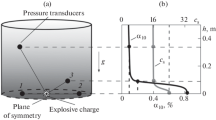Abstract
Mitigation of blast waves in aqueous foams is a problem that has a strong dependence on multi-phase effects. Here, a simplified model is developed from the previous articles treating violent flows (D’Alesio et al. in Eur J Mech B Fluids 54:105–124, 2015; Faure and Ghidaglia in Eur J Mech B Fluids 30:341–359, 2011) to capture the essential phenomena. The key is to have two fluids with separate velocities to represent the liquid and gas phases. This allows for the interaction between the two phases, which may include terms for drag, heat transfer, mass transfer due to phase change, added mass effects, to be included explicitly in the model. A good test for the proposed model is provided by two experimental data sets that use a specially designed shock tube. The first experiment has a test section filled with spray droplets, and the second has a range of aqueous foams in the test section. A substantial attenuation of the shock wave is seen in both cases, but a large difference is observed in the sound speeds. The droplets cause no observable change from the air sound speed, while the foams have a reduced sound speed of approximately 50–75 \(\hbox {m}/\hbox {s}\). In the model given here, an added mass term is introduced in the governing equations to capture the low sound speed. The match between simulation and experiment is found to be satisfactory for both droplets and the foam. This is especially good when considering the complexity of the physics and the effects that are unaccounted for, such as three-dimensionality and droplet atomisation. The resulting statistics illuminate the processes occurring in such flows.















Similar content being viewed by others
Abbreviations
- \(\alpha \) :
-
Thermal diffusivity
- \(\alpha _k\) :
-
Volume fraction of species k
- \(\delta \) :
-
Density fraction
- \(\gamma \) :
-
Ratio of specific heats
- \(\kappa \) :
-
Non-dimensional constant
- \(\nu \) :
-
Viscosity
- \(\phi \) :
-
Expansion ratio \(=1/\alpha _{\text {w}}\)
- \(\pi \) :
-
Pressure constant
- \({\varPi }_{\text {w}}\) :
-
Stiffened gas pressure constant
- \(\rho \) :
-
Density
- \(\rho _k\) :
-
Fluid density of species k
- \(\theta _\rho \) :
-
Non-dimensional coefficient
- c :
-
Sound speed
- \(C^*\) :
-
Non-dimensional coefficient
- \(C_v\) :
-
Specific heat capacity at constant volume
- \(C_{\text {drag}}\) :
-
Drag coefficient
- \(D_{\text {ST}}\) :
-
Shock tube diameter
- \(e_k\) :
-
Specific internal energy of species k
- \(E_k\) :
-
Total specific energy of species k
- F :
-
Flux vector
- \(f_k\) :
-
Added mass term of species k
- \(h_k\) :
-
Specific enthalpy of species k
- \(H_k\) :
-
Total specific enthalpy of species k
- \(L_{\text {HP}}\) :
-
High-pressure chamber length
- \(L_{\text {ST}}\) :
-
Shock tube length
- M :
-
Mach number
- \(N_x\) :
-
Number of cells
- p :
-
Pressure
- Q :
-
Phase transfer terms
- \(r^*\) :
-
Length scale
- S :
-
Source term matrix
- t :
-
Time
- \(T_k\) :
-
Temperature of species k
- \(u_k\) :
-
Velocity of species k
- v :
-
Vector of conserved variables
- x :
-
Position in shock tube
- CFL:
-
CFL number
References
Del Prete, E., Chinnayya, A., Domergue, L., Hadjadj, A., Haas, J.-F.: Blast wave mitigation by dry aqueous foams. Shock Waves 23, 39–53 (2013). https://doi.org/10.1007/s00193-012-0400-0
Chauvin, A., Daniel, E., Chinnayya, A., Massoni, J., Jourdan, G.: Shock waves in sprays: numerical study of secondary atomization and experimental comparison. Shock Waves 26(4), 403–415 (2016). https://doi.org/10.1007/s00193-015-0593-0
Labourdette, C., Ghidaglia, J.-M., Redford, J.A., Faure, S.: Accurate state variables for fluid flow simulation using Quicksteam and Quickmethane. Eur. J. Mech. B Fluids 65, 132–240 (2017). https://doi.org/10.1016/j.euromechflu.2017.03.003
Bestion, D.: The physical closure laws in the CATHARE code. Nucl. Eng. Des. 124, 229–245 (1990). https://doi.org/10.1016/0029-5493(90)90294-8
Faure, S., Ghidaglia, J.-M.: Violent flows in aqueous foams I: physical and numerical models. Eur. J. Mech. B Fluids 30, 341–359 (2011). https://doi.org/10.1016/j.euromechflu.2011.03.003
Wood, A.B.: A Textbook of Sound. G. Bell and Sons Ltd, London (1930)
Atkinson, C.M., Kytömaa, H.K.: Acoustic wave speed and attenuation in suspensions. Int. J. Multiphase Flow 18(4), 577–592 (1992). https://doi.org/10.1016/0301-9322(92)90053-J
Temkin, S.: Sound speeds in suspensions in thermodynamic equilibrium. Phys. Fluids 4(11), 2399–2409 (1992). https://doi.org/10.1063/1.858481
Britan, A., Shapiro, H., Liverts, M., Ben-Dor, G.: Macro-mechanical modeling of blast-wave mitigation in foams. Part III: verification of the models. Shock Waves 24(3), 241–256 (2014). https://doi.org/10.1007/s00193-013-0485-0
Jourdan, G., Biamino, L., Mariani, C., Blanchot, C., Daniel, E., Massoni, J., Houas, L., Tosello, R., Praguine, D.: Attenuation of a shock wave passing through a cloud of water droplets. Shock Waves 20, 285–296 (2010). https://doi.org/10.1007/s00193-010-0251-5
Jourdan, G., Mariani, C., Houas, L., Chinnayya, A., Hadjadj, A., Del Prete, E., Haas, J.-F., Rambert, N., Counilh, D., Faure, S.: Analysis of shock-wave propagation in aqueous foams using shock tube experiments. Phys. Fluids 27, 056101 (2015). https://doi.org/10.1063/1.4919905
Wallis, G.B.: Critical two-phase flow. Int. J. Multiphase Flow 6(1–2), 97–112 (1980). https://doi.org/10.1016/0301-9322(80)90041-5
De Lorenzo, M., Lafon, Ph, Seynhaeve, J.-M., Bartosiewicz, Y.: Benchmark of Delayed Equilibrium Model (DEM) and classic two-phase critical flow models against experimental data. Int. J. Multiphase Flow 92, 112–130 (2017). https://doi.org/10.1016/j.ijmultiphaseflow.2017.03.004
D’Alesio, S., Dias, F., Faure, S., Ghidaglia, J.-M., Labourdette, C., Pougeard-D’Ulimbert, T., Sollier, A.: Violent flows in aqueous foams II: simulation platform and results. Eur. J. Mech. B Fluids 54, 105–124 (2015). https://doi.org/10.1016/j.euromechflu.2015.06.011
Thorley, A.R.D., Wiggert, D.C.: The effect of virtual mass on the basic equations for unsteady one-dimensional heterogeneous flows. Int. J. Multiphase Flow 11(2), 149–160 (1985). https://doi.org/10.1016/0301-9322(85)90042-4
Kytömaa, H.K.: Theory of sound propagation in suspensions: a guide to particle size and concentration characterization. Powder Technol. 82(1), 115–121 (1995). https://doi.org/10.1016/0032-5910(94)02901-Y
Ghidaglia, J.-M., Kumbaro, A., Le Coq, G.: On the numerical solution to two fluid models via a cell centered finite volume method. Eur. J. Mech. B Fluids 20, 841–867 (2001). https://doi.org/10.1016/S0997-7546(01)01150-5
Ghidaglia, J.-M., Pascal, F.: The normal flux method at the boundary for multidimensional finite volume approximations in CFD. Eur. J. Mech. B Fluids 24(1), 1–17 (2005). https://doi.org/10.1016/j.euromechflu.2004.05.003
Stewart, H.B.: Stability of two-phase flow calculation using two-fluid models. J. Comput. Phys. 33(2), 259–270 (1979). https://doi.org/10.1016/0021-9991(79)90020-2
Trotter, H.F.: Approximation of semi-groups of operators. Pac. J. Math. 8(4), 887–919 (1958). https://doi.org/10.2140/pjm.1958.8.887
Del Prete, E., Haas, J.-F., Counilh, D., Rambert, N., Ballanger, F., Houas, L., Jourdan, G., Mariani, C., Chinnayya, A., Hadjadj, A., Faure, S.: Propagation d’une onde de choc dans une mousse aqueuse, Chocs Avancées / Bilan 2015 Des Publications et de la Vie Scientifique De La Direction Des Applications Militaires, pp. 18–19 (2016)
Ishii, M., Hibiki, T.: Thermo-Fluid Dynamics of Two-Phase Flow. Springer, New York (2006). https://doi.org/10.1007/978-1-4419-7985-8
Acknowledgements
We would like to thank CEA LRC Méso, for partly funding this work.
Author information
Authors and Affiliations
Corresponding author
Additional information
Communicated by A. Hadjadj.
Publisher's Note
Springer Nature remains neutral with regard to jurisdictional claims in published maps and institutional affiliations.
Appendix
Appendix
Here we consider the basic two-fluid model of [22], which is written as (\(\ell =1\) or 2):
where
These differential equations are supplemented by three algebraic relations:
Systems (22) to (24) can be written as a quasilinear system:
and given a vector \(\xi \in {{\mathbb {R}}}^3\). We are interested in the eigenvalues of the \(10\times 10\) matrix
Since these numbers do not depend on the chosen set of dependent variables, we rewrite this system using the physical variables:
We also introduce the two classical thermodynamic coefficients
Using Gibbs relation: \(T_i \mathrm {d}s_i=\mathrm {d}e_i-\frac{p}{\rho _i^2}\mathrm {d}\rho _i,\) the previous equations are combined to produce:
where \(\rho \equiv \alpha _1\rho _1+\alpha _2\rho _2\). Let us now write (31) to (33) as a quasilinear system:
By taking \({{\underline{w}}}\) as a given constant state, the linearisation of (36) around this state is:
Hence, the eigenvalues we are looking for are complex numbers \(\lambda ({{\underline{w}}},\xi )\) such that there exists \({\varOmega }\in {{\mathbb {R}}}^{10}\) for which the plane wave:
is a nonzero solution of (37).
First, we observe that for this change of variables the system is block-diagonalised in the sense that equations (33), \(\ell = 1\) or 2, are, for the linearised system, uncoupled. Hence, \(\lambda ({{\underline{w}}},\xi )=u_{\text {i}}\cdot \xi \), where \(i=1,2\) are eigenvalues. Then, we can study the system in \((\alpha ,p,u_1,u_2)\), which corresponds to the isentropic model. By substituting (38) into (37), the following characteristic equation is obtained for \(\lambda =\lambda ({{\underline{w}}},\xi )\):
where
To determine the speed of sound in the mixture, we set \(u_1=u_2=0\), and in this case matrix N in (39) becomes:
It can easily be shown that the equation for \(\lambda \), (40), is
where
Rights and permissions
About this article
Cite this article
Redford, J.A., Ghidaglia, JM. & Faure, S. Violent flows in aqueous foams III: physical multi-phase model comparison with aqueous foam shock tube experiments. Shock Waves 28, 1263–1284 (2018). https://doi.org/10.1007/s00193-018-0835-z
Received:
Revised:
Accepted:
Published:
Issue Date:
DOI: https://doi.org/10.1007/s00193-018-0835-z




